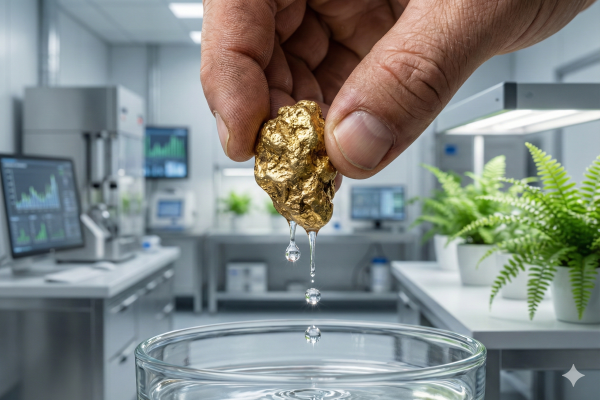June 24th, 2020 | 12:10 CEST
Barrick, Franco-Nevada, Yamana - Gold price at record high and now the second row is getting interesting
In the morning the price of gold rose to over USD 1,770.00, its highest level since 2012, and continues to gain momentum; there is no end in sight. The big gold companies can already profit from the price increase since May 2019. Their margins have risen significantly and profits are developing in line with this. The share prices of the largest companies reflect what shareholders are already benefiting from: the flight of money into gold is in full swing. Gold is virtually the only independent currency in the world. There are now many opportunities to profit from it.
time to read: 2 minutes
|
Author:
Mario Hose
ISIN:
CA0679011084 , CA3518581051 , CA98462Y1007
Table of contents:

"[...] Our district-scale 104,000-hectare land package already hosts the Barsele deposit (2.4Moz Au) and multiple new gold anomalies identified through modern exploration techniques. [...]" Taj Singh, CEO & Director, First Nordic Metals Corp.
Author
Mario Hose
Born and raised in Hannover, Lower Saxony follows social and economic developments around the globe. As a passionate entrepreneur and columnist he explains and compares the most diverse business models as well as markets for interested stock traders.
Tag cloud
Shares cloud
Golden times have begun
When Barrick Gold, Franco-Nevada or Yamana Gold have gold produced and sold by their projects or their related companies, they are currently generating more profit than in the past eight years. The demand for gold has been rising for months and is gaining further momentum with the actions taken to combat the effects of the Corona Pandemic. By increasing the money supply, citizens rightly fear that their money will be worth less as a result of inflation. This assumption is well-founded and is supported by the US banks. Goldman Sachs recently raised its target price for gold from USD 1,800.00 to USD 2,000.00 per troy ounce for the next 12 months. The Bank of America even believes that a gold price of up to USD 3,000.00 in 2021 is possible.
Gold supply will decline
On the occasion of the rising gold price it is therefore obvious that producers will try to increase their quantities in order to maximise profits now and today. On the other hand, the reserves of the largest producers have been steadily decreasing since 2012, with a decline of around 34%. It is expected that a historic peak production of around 118 million ounces will be reached in 2020, which from today's perspective will then, due to a lack of permits and reserves, drop by around 45% to around 62 million ounces per year by 2029. Two things become clear from this: 1. supply is diametrically opposed to demand, which should give the price increase a further boost and 2. sooner or later producers with a lot of money in their coffers will start to take over the smaller market participants in order to rebuild the reserves.
Diversification with takeover candidates
In addition to the well-known names from the gold sector, shares of smaller companies are an ideal addition to the portfolio, as they are predestined as takeover candidates and already have well-known investors on board. At SolGold (solgold.com.au), with a focus on gold and copper, BHP is already the largest investor with a foot in the door. At Triumph Gold (triumphgoldcorp.com), the giant Newmont already holds 18% and is thus the largest single shareholder. Billionaire Eric Sprott joined gold explorer Scottie Resources (scottieresources.com) at the beginning of the year and has since held a stake of around 10%. The Canadian raw materials expert Ross Beaty is involved in Desert Gold Ventures (desertgold.ca) and Osino Resources (osinoresources.com).
In these smaller companies, investors have the advantage that when the price of gold rises, not only does the probability of a takeover increase, but the price per ounce in the ground also rises. With luck, the investors can multiply their investment.
Conflict of interest
Pursuant to §85 of the German Securities Trading Act (WpHG), we point out that Apaton Finance GmbH as well as partners, authors or employees of Apaton Finance GmbH (hereinafter referred to as "Relevant Persons") may in the future hold shares or other financial instruments of the mentioned companies or will bet on rising or falling on rising or falling prices and therefore a conflict of interest may arise in the future. conflict of interest may arise in the future. The Relevant Persons reserve the shares or other financial instruments of the company at any time (hereinafter referred to as the company at any time (hereinafter referred to as a "Transaction"). "Transaction"). Transactions may under certain circumstances influence the respective price of the shares or other financial instruments of the of the Company.
Furthermore, Apaton Finance GmbH reserves the right to enter into future relationships with the company or with third parties in relation to reports on the company. with regard to reports on the company, which are published within the scope of the Apaton Finance GmbH as well as in the social media, on partner sites or in e-mails, on partner sites or in e-mails. The above references to existing conflicts of interest apply apply to all types and forms of publication used by Apaton Finance GmbH uses for publications on companies.
Risk notice
Apaton Finance GmbH offers editors, agencies and companies the opportunity to publish commentaries, interviews, summaries, news and etc. on news.financial. These contents serve information for readers and does not constitute a call to action or recommendations, neither explicitly nor implicitly. implicitly, they are to be understood as an assurance of possible price be understood. The contents do not replace individual professional investment advice and do not constitute an offer to sell the share(s) offer to sell the share(s) or other financial instrument(s) in question, nor is it an nor an invitation to buy or sell such.
The content is expressly not a financial analysis, but rather financial analysis, but rather journalistic or advertising texts. Readers or users who make investment decisions or carry out transactions on the basis decisions or transactions on the basis of the information provided here act completely at their own risk. There is no contractual relationship between between Apaton Finance GmbH and its readers or the users of its offers. users of its offers, as our information only refers to the company and not to the company, but not to the investment decision of the reader or user. or user.
The acquisition of financial instruments entails high risks that can lead to the total loss of the capital invested. The information published by Apaton Finance GmbH and its authors are based on careful research on careful research, nevertheless no liability for financial losses financial losses or a content guarantee for topicality, correctness, adequacy and completeness of the contents offered here. contents offered here. Please also note our Terms of use.




